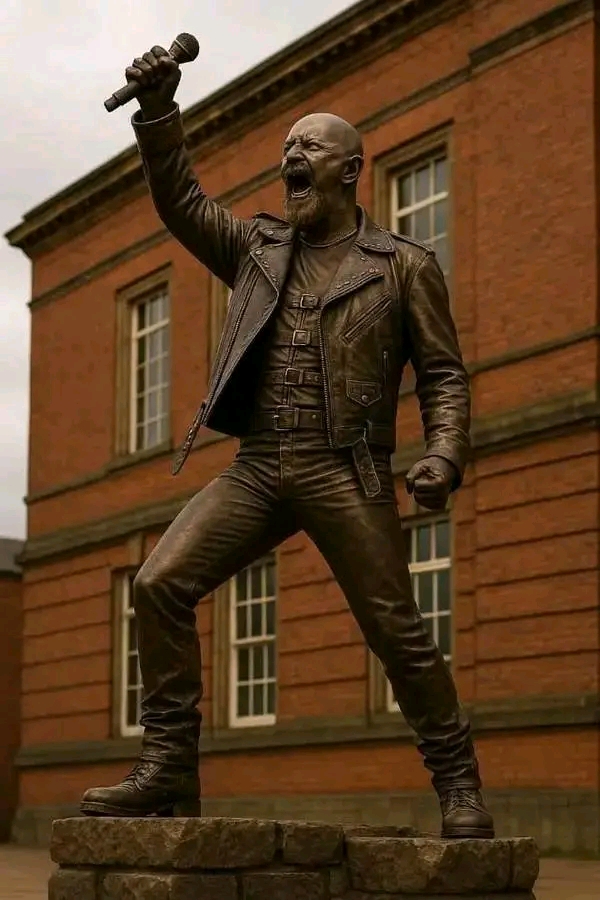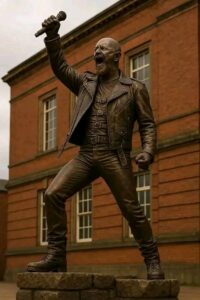
In the sprawling landscape of heavy metal, where thunderous riffs and thunderous vocals collide, one name resonates with unparalleled reverence: Rob Halford. Known worldwide as the legendary frontman of Judas Priest, Halford isn’t just a figure in music — he’s a monument, an icon, a standard that every aspiring rocker dreams of reaching. His story isn’t merely about music; it’s a testament to authenticity, resilience, and the power of staying true to oneself.
The Birth of a Legend
Born Robert John Arthur Halford on August 25, 1951, in Birmingham, England, Rob’s journey into the heart of metal was anything but conventional. Growing up in a working-class family, he discovered his love for singing early on, often singing along to his favorite records in his childhood home. But it was the burgeoning heavy metal scene of the 1970s that truly ignited his passion.
At a time when rock was evolving rapidly, Judas Priest emerged as a band unafraid to push boundaries. Rob’s commanding presence and soaring vocals quickly set him apart. His voice, a powerful blend of grit and grace, became the defining element of Judas Priest’s sound. It was a voice that could both shred and soothe, a duality that embodied the very essence of metal.
Breaking Barriers and Shattering Stereotypes
Rob Halford’s influence extended beyond his vocal prowess. He was one of the first heavy metal singers to embrace and openly express his identity as a gay man in a genre often criticized for its machismo. This decision was groundbreaking, challenging stereotypes and paving the way for greater acceptance within the metal community.
In interviews, Rob was candid about his sexuality, refusing to hide behind societal expectations. His honesty was met with both admiration and controversy, but he remained steadfast. His courage inspired countless fans who felt marginalized, proving that authenticity is the true mark of a legend.
The Iconic Persona and the Leather Queen
One of Halford’s most recognizable trademarks was his flamboyant stage persona. Clad in leather, studs, and often sporting a distinctive metal mask, he pushed the boundaries of stage theatrics. This look became synonymous with Judas Priest and heavy metal itself.
For Rob, the leather and spikes weren’t just costumes—they were symbols of defiance, freedom, and self-expression. His stage presence was a masterclass in commanding attention, blending raw power with charisma. Fans didn’t just see a singer; they saw an artist who embodied the rebellious spirit of metal.

A Career of Triumphs and Trials
Rob Halford’s career was not without its challenges. The band faced internal struggles, changing musical trends, and personal battles. In the early 1990s, Judas Priest disbanded, and Halford embarked on a solo career. During this hiatus, he explored different musical styles and worked on personal growth.
His return to Judas Priest in the early 2000s marked a new chapter, revitalizing the band and reaffirming his place as metal’s reigning king. Albums like Angel of Retribution and Redeemer of Souls showcased his enduring vocal power and songwriting talent.
Throughout his journey, Rob faced setbacks, including rumors of health issues and the pressures of maintaining his legendary status. Yet, he persisted—an embodiment of resilience that has become part of his legend.
The Standard Every Rocker Dreams Of Reaching
What makes Rob Halford a true monument isn’t just his vocal range or stage theatrics; it’s his unwavering commitment to authenticity. He stands as a beacon for artists across genres, exemplifying that success comes from staying true to oneself, regardless of societal expectations.
His influence is evident in countless metal acts that cite him as an inspiration. From the vocal stylings of Bruce Dickinson to the rebellious spirit of bands like Metallica and Slipknot, Halford’s legacy is woven into the fabric of heavy metal.
A Lasting Impact
Beyond the stage, Rob has used his platform to promote equality and acceptance. His openness about his sexuality has helped challenge prejudices and fostered a more inclusive scene within metal. He’s also an advocate for mental health awareness, emphasizing the importance of staying true to oneself through adversity.
In interviews, Rob often speaks about his gratitude for the fans who have supported him through decades. “Music is about honesty,” he once said. “It’s about expressing who you are, no matter what others think.”
The Monument in the Making
As he approaches his seventies, Rob Halford’s influence continues to grow. His voice remains powerful, his message still relevant. The Metal God, as he’s often called, has become more than a musician; he’s a symbol of resilience, authenticity, and the relentless pursuit of one’s truth.
Fans and newcomers alike often visit memorials, murals, and even dedicated spaces celebrating his legacy. The “Monument of Rob Halford” isn’t merely a physical structure; it’s an ongoing tribute to a man who redefined what it means to be a rock star.
In Conclusion
Rob Halford isn’t just a legend — he is the standard every rocker dreams of reaching. His story is a narrative of defiance, authenticity, and unwavering passion. Through his voice, image, and actions, he has set a benchmark for generations to come.
In a world obsessed with conformity, Rob Halford stands tall as a monument, reminding us all that true greatness is born from staying true to oneself. His journey proves that at the core of every legendary figure is an unyielding commitment to authenticity—a lesson that resonates far beyond the stage.
To call him merely a musician would be an injustice. Rob Halford is a movement, an icon, a monument. And his legacy will echo through the halls of rock history forever.



